Assembling a High-End Mini-ITX PC in the SilverStone RVZ02
Introduction
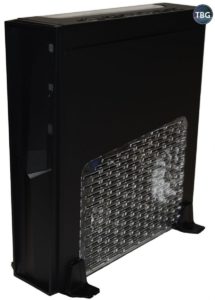 Here at The Tech Buyer’s Guru, we have a thing for Small Form Factor PCs. That’s why we’ve put together an entire section of our buyer’s guides dedicated to them. But sometimes knowing which parts to buy isn’t quite enough, as SFF PCs take a bit more patience and problem-solving to build as well. And when you want to really push the limit, there are lots of things that can get in your way: clearance issues for CPU coolers, power supplies, RAM, and video cards, along with airflow issues that can bring an ultra-high-end build to its knees. That’s why we’ve created this step-by-step guide.
Here at The Tech Buyer’s Guru, we have a thing for Small Form Factor PCs. That’s why we’ve put together an entire section of our buyer’s guides dedicated to them. But sometimes knowing which parts to buy isn’t quite enough, as SFF PCs take a bit more patience and problem-solving to build as well. And when you want to really push the limit, there are lots of things that can get in your way: clearance issues for CPU coolers, power supplies, RAM, and video cards, along with airflow issues that can bring an ultra-high-end build to its knees. That’s why we’ve created this step-by-step guide.
To be frank, this isn’t our first attempt at putting together a guide like this. Back in 2014, we built our first ITX-based system, which was supposed to be the ultimate guide to building a high-end gaming machine in a tiny box. We ended up having some major power supply fitment issues, however, so that project turned out to be more of a cautionary tale than the true last word in ITX builds.
What have we changed this time around? Well, we’re sticking with more parts that are guaranteed to work together, and we’re using the latest iteration of Silverstone’s ITX case design, the Raven RVZ02, which is new and improved in just about every way versus the older RVZ01, as well as many of Silverstone’s shoebox-style cases, which always had significant limitations due to their form factor.
So let’s get right to it then. Here’s our complete parts list:
- CPU: Intel Core i7-6700K
- Motherboard: Asus Z170I Pro Gamer
- Video Card: EVGA GeForce GTX 980 Ti 6GB (for benching) and Sapphire Radeon R9 290 Tri-X 4GB (for fit only)
- RAM: G.Skill 2x8GB RipJaws DDR4-3000
- Solid State Drive #1: Samsung 850 Evo M.2 500GB
- Solid State Drive #2: Samsung 850 Evo 500GB
- Case: Silverstone Raven RVZ02B-W
- Power Supply: Silverstone SX500-LG
- Optical Drive: Samsung Internal Slim DVD Burner
- CPU Cooler: Thermalright AXP-100 Muscle (due to compatibility issues, we strongly recommend the SilverStone AR06 instead)
- Operating System: Windows 10
Below you can see just about all of our parts selections prior to diving into the build:
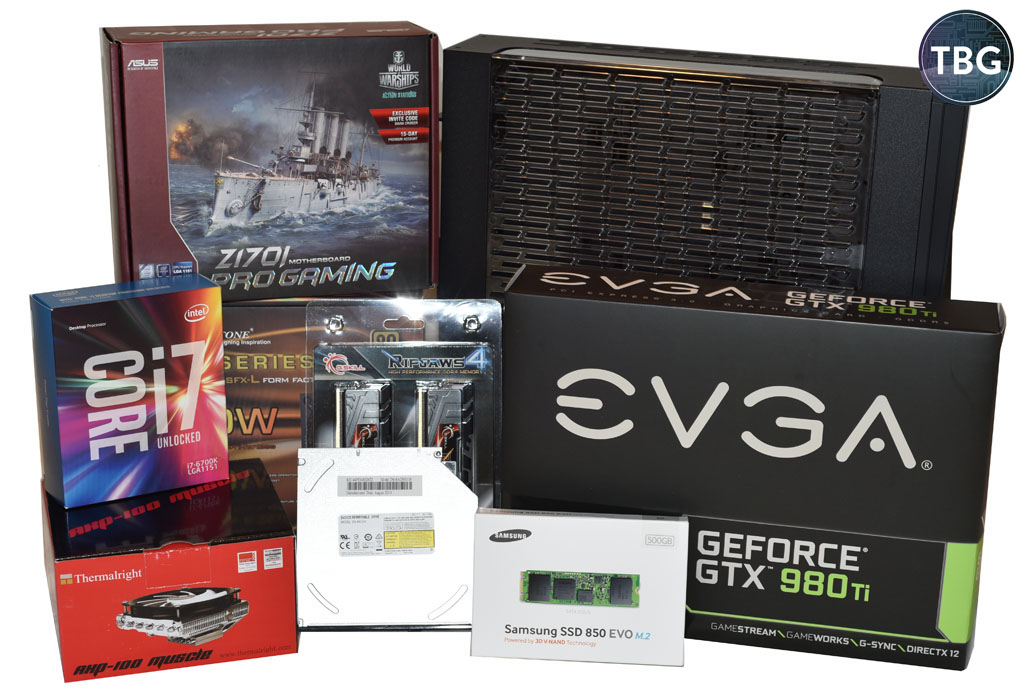
A couple of notes before getting into the build. Silverstone is known for making markets for its own SFF gear. We applaud them for finally ditching the requirement of a slot-loading optical drive with the new RVZ02, which has previously been mandatory with nearly all of its high-end ITX cases. But being under 4″ thick, the RVZ02 still requires one of Silverstone’s unique SFX power supplies, and we chose the extended SFX-L model, which was basically designed for the RVZ01/02 series. That means it’s (almost) sure to fit, but it’s also a bit expensive, being a limited-production item with a very niche market. Luckily, based on previous testing, we know that the 500W it has on tap is more than sufficient to power this build. The other major limitation of the RVZ02 case is CPU cooler height; at 58mm, clearance is very tight. One of our favorite compact coolers, the Noctua NH-L9x65, was ruled out based on a 65mm height, and while Silverstone’s own AR06 would just barely fit, we wanted to try something with a bit more cooling power. We turned to Thermalright for its AXP-100 Muscle, which comes in at 58mm tall despite packing in a big 100mm fan, making it the largest cooler that would theoretically fit. We’ll see soon enough whether our gamble paid off!
OK, that’s all for the introduction, ready for the main event?!?
Building the Box
The first major challenge presented by this build, as discussed on the previous page, was finding components that would actually fit inside the slim Silverstone RVZ02 case and still provide high-end performance. Due to a thickness of less than 4″, almost every single CPU cooler on the market has to be immediately ruled out, including all liquid coolers. And that’s complicated by the fact that the RVZ02 has absolutely no options for active cooling. You get some large side vents and that’s about it. So if you don’t choose your components wisely, you’ll end up in an overheating situation pretty quickly. You can certainly use a dual-core processor with Intel’s stock cooler, but we wanted to try cramming in Intel’s high-powered Core i7-6700K quad-core CPU, and even wanted to dip our toe into the overclocking waters with it. Rest assured, this is not an easy thing to do with the RVZ02.
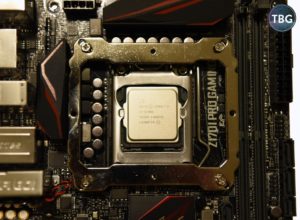
In the end, we took a chance on a cooler that, based on its 58mm height, seemed like it might just fit. We never do this in our buyer’s guides, because we don’t want to leave our readers with components that don’t work together. And that’s a common problem in online forums: you ask a question, and you’ll get a number of responses that don’t fully consider the limitations of the particular build you have in mind. In the end, our combination of CPU cooler, motherboard, and RAM did just barely fit together, but as you’ll see, we do mean just barely. In the photo to the right, you can see our Core i7-6700K processor surrounded by the CPU cooler mount. Note the position of the mount in relation to the motherboard heatsink on the left and the RAM slots on the right. And that wasn’t the worst of it; we actually had to bend up two tiny fins on our heatsink to clear the motherboard’s WiFi module (visible in the lower-left corner of the photo, extending further than it should into the CPU area). This, dear readers, is what we call a close call! Let this serve as a reminder that you really can’t just go off of specs alone when pushing the limits of an ITX build.

The next step was to flip the board over and install the M.2 solid-state drive, shown in the photo to the left. M.2-style drives are all the rage right now, but there’s plenty of confusion about how they work. The first thing to keep in mind is that there are multiple types of physical connectors (M-type being the most common on high-performance drives), but secondly, there are two types of underlying interfaces, SATA and PCIe. All SATA M.2 drives will work just like their 2.5″ cousins – nothing separates their performance in the slightest. PCIe drives are much, much faster, but are also about twice the cost per gigabyte.
We went with a SATA-based Samsung 850 Evo 500GB more for the purpose of clearing out some space in our system, and also to experiment with the use of M.2 drives on the back of ITX boards (where they must reside on such a small PCB). To install the drive, you’ll need to first screw in the attachment pin, then insert the drive not unlike a stick of RAM, and then secure the drive with a tiny screw (having an eyeglass screwdriver will prove handy here!). Alas, we came away a bit less than impressed with the behavior of the drive in this system and wouldn’t recommend the use of M.2 drives on ITX boards, as we’ll discuss in the performance section.
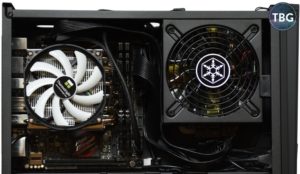
In the photo above, you can see the cooler mounted on the motherboard, which is now installed inside the case, flanked by the power supply to its right. Also note the RAM sticks – they are literally right up against the heatpipes on the right side of the cooler. This was a very close call indeed. By the way, we should note that while the flat-style cables of the Silverstone power supply look pretty sleek, they aren’t ideal for small cases where you have to make a lot of tight bends to get around components. That’s a bit ironic considering it’s designed specifically for such cases.

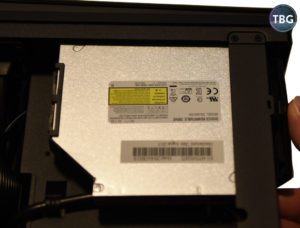
We were very happy to see, as mentioned before, that the Raven RVZ02 is compatible with low-cost laptop-style optical drives. We picked up a great drive for about $20, but knew going in that an adapter would be necessary to convert the laptop-size SATA power connector to the desktop-size power connector. We turned to a one-piece StarTech adapter that we had on hand, and it worked… for the most part. Unfortunately, it was a very tight fit, pushing up against the side of the case when installed. We’d instead recommend StarTech’s two-piece SATA converter, which moves the bulky desktop-style connectors away from the drive and thus the side of the case.
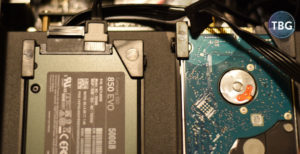
The next challenge we faced was one that we didn’t realize Silverstone had in store for us. The drive bays are all tool-less, with the dual 2.5″ trays swinging upwards to drop drives in, and the optical drive sliding in from the front and locking in with a handy snap panel. No screws required! The only problem was the layout and distance between the drives. The Silverstone SX500-LG power supply was essentially custom-made for the Raven ITX series, and yet the spacing on the single strand of SATA power connectors was all wrong for this case. There’s simply no way to connect the optical drive and two 2.5″ drives without the use of third-party extension cables. And that’s a major oversight on Silverstone’s part. For components that practically won’t see the light of day in any other application, these should fit hand in glove, and they do not. While our build didn’t require a fourth drive (beyond the M.2 SSD, 2.5″ SSD, and optical drive), we attempted to install a 2.5″ hard drive for illustration purposes, and there was simply no way to do it with the parts we were using. If builders use the two-piece StarTech SATA adapter we suggested in the previous paragraph and flip the order of the three power connectors, however, there will be just enough reach to make it all come together. Still, this work-around just shouldn’t be necessary.
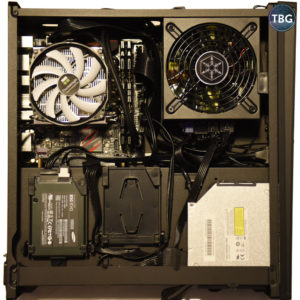
All right, with that challenge over with, we can show you the complete “topside” installation in the RVZ02. This includes the motherboard, CPU, RAM, power supply, SSDs, and optical drive, and despite Silverstone’s best efforts to thwart us, the cabling. Yes, cabling is a very important task in ITX cases, so failing to include a discussion of the difficulty, or just skipping the cabling all together as is often done in many media promo photos, just wouldn’t do justice to the challenge of building ITX systems. Apart from the aforementioned flat-style PSU cables, the USB 3.0 cable was absurdly-long for this application, as if Silverstone pulled it off the shelf from one of its huge super-tower ATX cases. The mess of round cables you can see hovering over the motherboard and touching the CPU cooler is the USB 3.0 cable, and it really is impossible to route in an ideal fashion. By the way, we should mention that while Silverstone markets a Short Cable Set for its ITX cases, we don’t recommend its use in this case, which is actually quite spread out for an ITX design.
All right, let’s flip this baby over to bolt in our monster video card and then give it some gas!
Video Card Magic
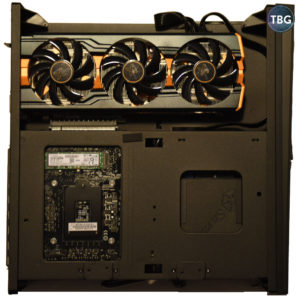
We benched this system with an EVGA GeForce GTX 980 Ti ACX 6GB video card, which we’ll show you installed in a moment, but first we wanted to illustrate how truly cavernous the video card bay of the RVZ02 is. Here you can see the Sapphire Radeon R9 290 Tri-X 4GB installed in the case. At over 12″ long, it’s the biggest video card we have in our test stable, and even it easily slips right into the RVZ02 case. That’s pretty impressive for a case as portable as the RVZ02. It’s almost as if Silverstone designed the RVZ02 to be a video card with a PC strapped to its back.
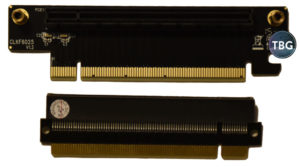
Before moving onto the GeForce and our performance figures, we should mention the truly brilliant magic trick that Silverstone has conjured up to make this video card sleight of hand possible. It’s a two piece PCIe adapter, shown here. The top adapter serves to turn the PCIe slot 90 degrees, and the bottom adapter extends it into the video card bay on the flipside of the case. Nothing too fancy, but this custom bit of engineering works exactly as intended and fits perfectly in this case. Clearly, this is one example of Silverstone actually tailoring a component to a specific application and getting the enginnering just right.
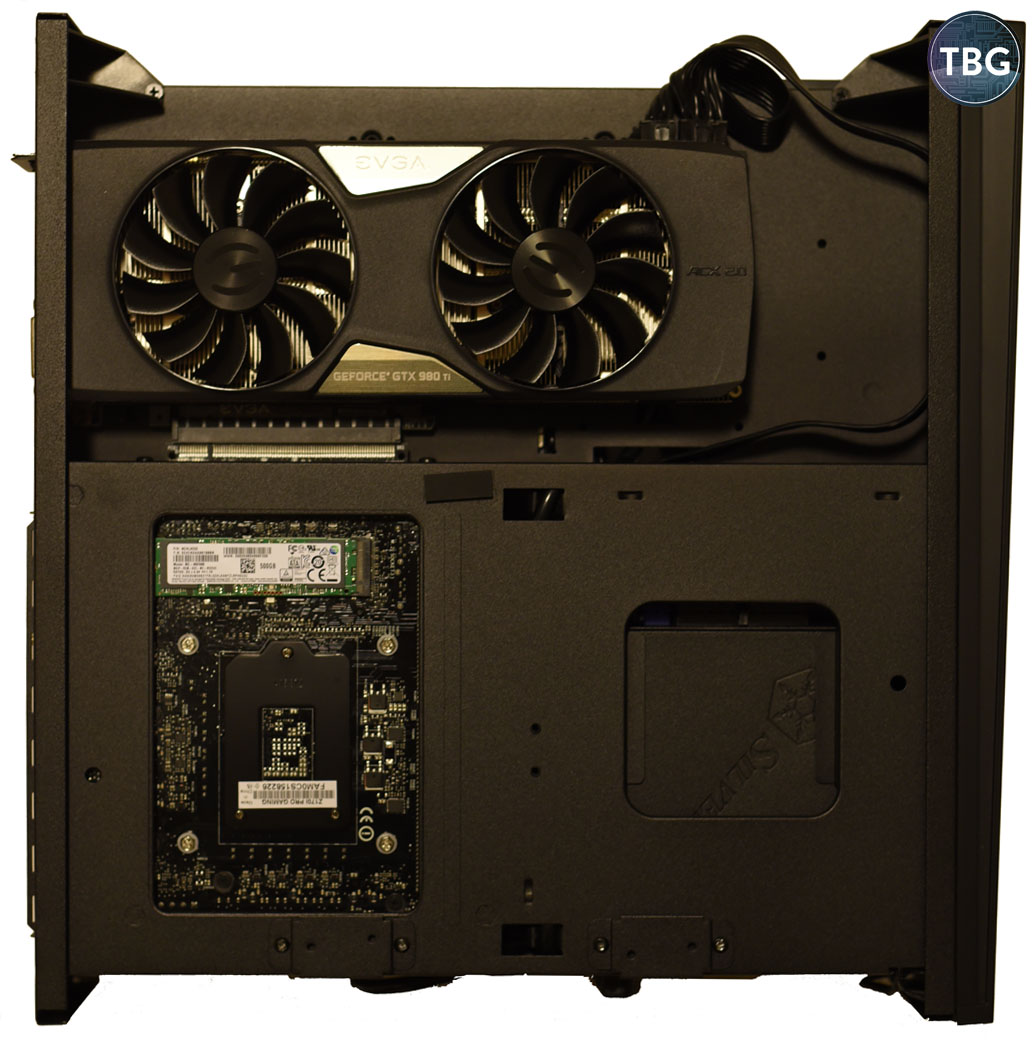
All right, enough ooh-ing and ah-ing, time to get our GeForce card installed. In the RVZ02, the 10.5″ GTX 980 Ti looks positively tiny. And that’s a good thing, because it means the card will have plenty of room to breathe. While we typically recommend blower-style cards for ITX cases, in the RVZ02, they aren’t necessary, as the video card essentially has a mini-ecosystem all unto itself. It takes in air through exterior vents, exhausts air out the same vents, and never sends any of its hot exhaust towards other components. Well, actually, in our sample build, it does affect one component – the M.2 SSD. And, alas, we just don’t think these rear-mounted SSDs make much sense, because they’ll either be entirely unvented, or in the case of the RVZ02, they’ll be hit by tons of exhaust heat from the video card. It idled at a relatively-high 40 °C, and we routinely saw it hit above 50 °C under a gaming load. That’s just too high for comfort, given that SSDs typically operate closer to 30 °C in the 2.5″ form factor when exposed to standard case ventilation.
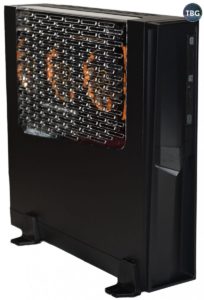
For the final “glamour shot”, we decided to photograph the system with the Radeon installed, as its bold coloring really shows off the acrylic side window of the RVZ02 case. Our EVGA GTX 980 Ti’s styling is significantly more subdued in comparison and just blends into the black background of the case interior. We should note that Silverstone also markets another version of the RVZ02, technically the RVZ02B rather than the RVZ02B-W that we tested, which eschews the transparent side panel for a meshed side panel instead. This is great for dust control, but perhaps not as good for aesthetics (depending on personal taste, of course). It will also cut down on airflow significantly, as the vented panel is smaller and obviously obstructed slightly by the mesh. We recommend it primarily for home theater PC use, while the version we profile here is really better for a high-end gaming machine.
Unfortunately, we can’t end our discussion of building this system without a bit more bad news. The Silverstone SX500-LG, while more than up to the task of powering our mini-monster, was not a particularly docile creature. Sure, it shuts its fan off at idle, which is a neat feature, but once it spins up, some pretty nasty traits become apparent. Its fan bearings just aren’t properly balanced, and when it’s in the middle of its RPM range, it emits a noticeable scratching sound that is far louder and more obnoxious than any of the other fans in the case. And that’s a shame, because at full-tilt, the power supply is fairly quiet. As we’ve said before and we’ll say again, Silverstone is a master of theoretical design, but this slip up is pretty unacceptable in a power supply as expensive as the SX500-LG, and the unit is clearly of lower quality than any other ~$100 power supply we’ve tested. [Update: we took advantage of Amazon’s amazing return policy on defective products, getting a new SX500 cross-shipped to us at no cost, and we’re happy to report that the replacement sounds much better than the original. We recommend that if you buy this model, you get it from Amazon as well].
Next, we’ll give you some performance metrics and provide our closing thoughts on our latest foray into the world of ITX computing.
Performance
Building a mini-ITX system, particularly one intended to offer extreme performance, is always going to be a challenge. We’ve already shared some of the many head-scratching moments we faced as we put this PC together. But getting it pieced together was only half the battle. We had to push it hard to see if it would hold together under stress. And as we’ve already suggested, we learned a thing or two once we hit the power button.
First we had to get a handle on Intel’s new Skylake platform. Using an early UEFI that shipped with the motherboard, we found that stock voltage was surprisingly high, around 1.28V. That leads to unnecessary heat and power use. It wasn’t until we flashed the board with the latest UEFI (from November 2015) that stock voltage dropped to more reasonable levels (around 1.24V). That’s still much higher than previous Ivy Bridge and Haswell systems, and it meant identifying the best overclocking settings would be a bit of a challenge. Additionally, we found that Multi-Core Enhancement, which runs the cores at Turbo speed (4.2GHz) under all loads, is no longer available on its own – you must also engage the XMP memory profile. This probably came as a result of complaints (mostly from reviewers) that motherboard manufacturers were running CPUs at overclocked settings to juice the benchmarks, without informing end users.
In any event, the 6700K runs at 4GHz in anything but a single-core load, which basically doesn’t exist in the real world. This is unlike previous Core i7 chips, as well as other chips in the Skylake series, which Turbo to something higher than their rated speed even under maximum load. So stock speed is 4GHz in our benchmarks. With a bit of experimentation, we were able to take it the chip to 4.4GHz with a -0.1V voltage offset. Yes, you read that right, we overclocked and undervolted! When overclocking, however, the motherboard does some of its own voltage adjustments, so we ended up at around 1.2V when overclocked. This was as high as we were comfortable going, because under our Intel Burn Test stress test, the system came perilously close to the 100 °C throttling threshold. Remember, we’re dealing with an ultra-slim chassis with no active cooling, and a very compact CPU cooler. Overall, this just isn’t the system to hone your competitive overclocking skills with.
Luckily, we had plenty of experience with our GTX 980 Ti, so we knew exactly what it could do. We first benched it at stock speeds, which for our sample translate to 1202MHz core under load and 7000MHz memory (not all stock-clocked cards hit the same clocks, surprisingly!). We then took it straight to 1400MHz (that’s a +200MHz offset in your favorite GPU tuning application), plus a 400MHz memory offset to hit 7800MHz (note the double-data rate math there). Because of the excellent cooling afforded by the practically open-air video card compartment, our GTX 980 Ti fared just as well in the RVZ02 case as it did in our big ATX test bench cooled by a multitude of high-speed case fans.
We also had a bit more luck with memory overclocking than we’ve had with the ultra-high-end Haswell-E platform. We took our DDR4-3000 kit straight to 3000MHz, up from the default 2133MHz, dialing in sub-timings of 15-15-15-35-1T, at a voltage of 1.35V. Note that by default our sticks, which were designed for Haswell-E motherboards, wanted to use a silly 125MHz strap in order to engage the XMP profile, so we simply set it manually. Skylake, unlike Haswell-E, allows for speeds above 2666MHz without resorting to overclocked straps.
So, how does this system perform? In 3DMark, we were able to hit a score well beyond what any previous quad-core system could achieve, even with the modest CPU overclock. Focus on the yellow bars, which represent this build as overclocked. For comparison purposes, we’ve included the stock-clocked data, as well as numbers from our Project ITX build, which utilized the shoebox-style Silverstone SG08 case with two different component configurations.
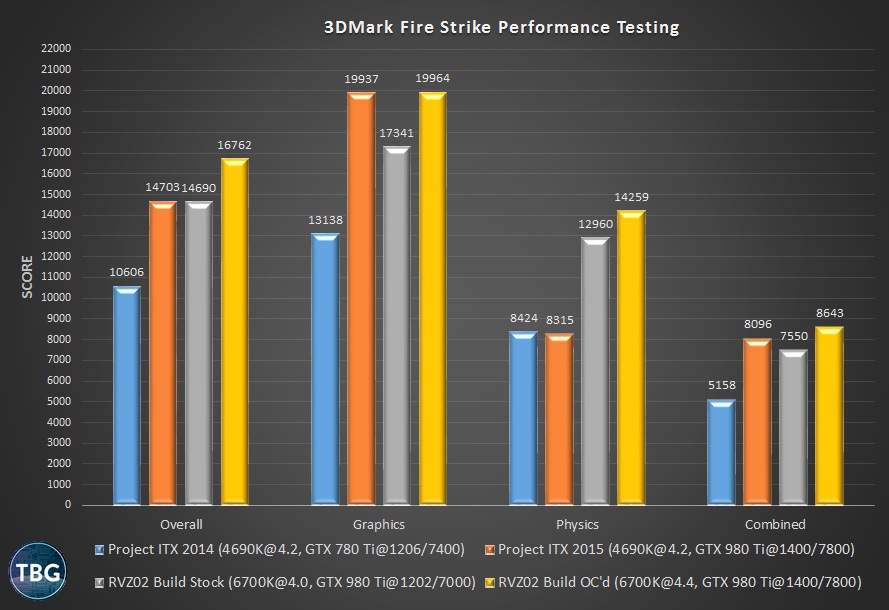
Impressive. We were running a 10% overclock on the CPU, cooled by a short-stack cooler with a slimline 100mm fan. And it turned in a perfect 10% gain in the Physics test (we love 3DMark for its accurate, linear CPU benchmark!). And our video card achieved a nice 17% overclock, which translated to a 15.1% performance increase. And this was all in a case less than 4″ thick. Wow! And it was all really efficient, too. At idle, the system drew just 40W, while under a full CPU/GPU load in the 3DMark Combined test, it hit 370W. As we said before, this didn’t even come close to stressing the power supply. How about temperatures? In the Intel Burn Test stress test, our Core i7-6700K hit 78 °C at stock speed and 93 °C overclocked, which is at the edge of our comfort level, but luckily will never be seen in typical use. Our idle and gaming data below provide a more real-world look at how the system performs, again compared to our Project ITX systems:
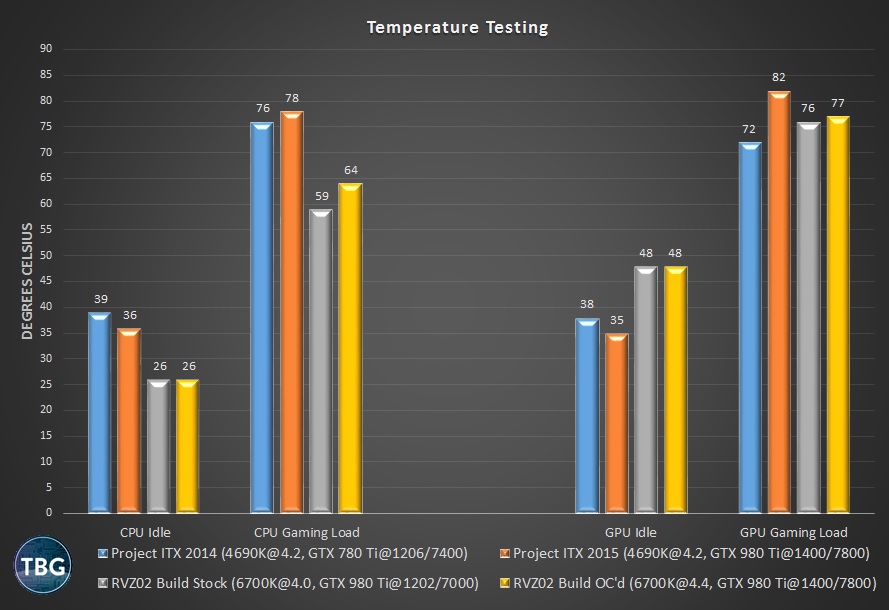
The results are pretty fantastic given the overall performance. Keep in mind that the GTX 980 Ti shuts off its fans at idle, as does the Silverstone power supply, making them both silent. And the CPU fan ran at only 1000RPM at idle, making it whisper-quiet. At load, the system was still very quiet. Note that the older Project ITX system used a passive CPU cooler, aided by the Silverstone SG08’s active case cooling, essentially the reverse of the RVZ02-based build. In just about every metric, the RVZ02’s thermal performance is superior.
Parting Thoughts
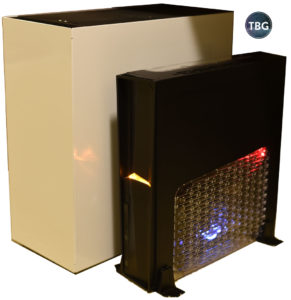
Here you can see our ITX build placed next to one of our most compact ATX builds, based on the sleek NZXT S340 chassis. Despite being able to pack in nearly all the same hardware (sans dual video cards and a big ATX PSU), the Raven looks quite petite here. And that’s what really makes it a fantastic pick for PC builders ready to accept its limitations. And there are several.
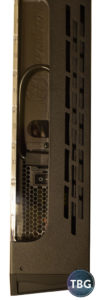
We’ve covered the cabling issues, the restrictions on CPU cooler height, and the power supply noise. But there was one other issue we identified when we closed up the case. Note that we flipped the system upside-down in the photo here to orient the CPU near the top, which is how most cases are oriented. We did this once we realized that Silverstone had made another poor design choice, which you can see in the photo to the left. In short, Silverstone somehow decided it would make sense to vent the power supply into the bottom of the case, which is nearly devoid of exterior vents, and then to have the user mount the case on feet that partially block the few vents that do exist. In our opinion, this is a recipe for long-term power supply failure, and seeing no significant consequences for component temperatures, we decided to run our system in the flipped orientation. It even places the power button up near the top, which makes it a whole lot more convenient to reach if the system is on the floor.
So, what have we learned? Time and time again, we’ve come to realize that building a mini-system, especially an extreme mini-system, can be a bit tricky with off-the-shelf parts. And it all starts with the case you choose. Silverstone produces more small form factor cases than any other company, which makes it a natural choice when seeking out just the right ITX case. There’s just no doubt that they are incredibly unique and innovative, and it’s clear that Silverstone has some of the best CAD designers in the business.
It’s also clear, however, based on our testing of half a dozen Silverstone cases over the years (all purchased at retail, we should add), that Silverstone has no one on staff that actually builds PCs. In fact, we’re pretty sure many of its cases are never even powered on by Silverstone with actual components and cables installed, because every single Silverstone case has some form of fit issue that calls into question its advertised component compatibility. Do we love Silverstone cases for their daring design? Yes, we do, but builder-friendly they are not. And Silverstone continues to toe the line of false advertising in the specifications it provides, with many theoretical component combinations it lists being impossible to install in practice. We’re concerned enough about this problem that we’ll no longer be recommending Silverstone cases that we or one of our intrepid readers haven’t fully vetted.
All that being said, there’s definitely a great market for the Silverstone RVZ02 case, and that is in home theater and couch gaming applications. It’s by far the slimmest case on the market that can fit high-end gear, and while we recommend limiting it to mid-range gear, that’s still going to be more then enough in an HTPC setup. There’s certainly no “HTPC” case outside of the ITX arena that comes anywhere near the svelte profile of the RVZ02. And by the way, while we didn’t show them in use in our article, the case does come with four rubber feet that can be affixed to one side of the case, allowing it to be positioned horizontally, as you’d do on an AV rack. At just 12 liters, it’s ultra-optimized for this type of setup – technically it’s even smaller than the 14.8-liter SG08 used in Project ITX, although it feels larger in hand due to being so tall and deep (making it far less portable, by the way).
In the end, it may seem that we harped a lot, maybe a bit too much, on the Silverstone RVZ02 case, and to a lesser extent on the Silverstone power supply. But in reality, the ITX experience very much comes down to the case and power supply you use, as they determine so many of the parameters of what you can do. We certainly applaud Silverstone for thinking out of the box with its multitude of small form factor offerings; we just wish they’d pay more attention to what goes in the box.
Building with ITX cases is always going to involve some give and take, and we’re here to make clear exactly what enthusiasts are in for, or up against, when they choose to take on their next ITX build. We’ve previously profiled some interesting takes on bookshelf ITX PCs by Antec and In-Win, the palm-sized Intel NUC, as well as the aforementioned Silverstone SG08. None of these cases is perfect, but they each have their application. We’ll be sure to profile other cases in the future as we continue to expand our coverage of the ITX universe. For all of our latest small form factor recommendations, definitely stop by our Small Form Factor Buyer’s Guides, which are updated monthly!
Update: Since publishing this guide, we’ve put together our Extreme Gaming ITX PC Assembly Guide using a case that is a better match for ultra-high-end video cards and extreme overclocking. Check it out if that sounds like what you’re looking for!
